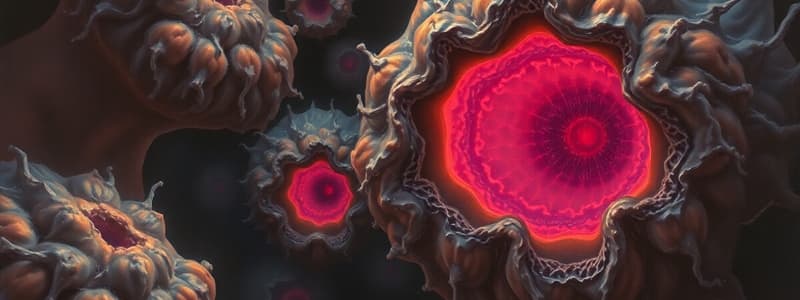Podcast
Questions and Answers
What characterizes a malignant tumor?
What characterizes a malignant tumor?
- It is completely harmless and does not require treatment.
- It invades surrounding tissues and can spread to other parts of the body. (correct)
- It remains localized to the original site.
- It consists only of abnormal cells.
What occurs to cancer cells that are not eliminated by the immune system?
What occurs to cancer cells that are not eliminated by the immune system?
- They remain in the bloodstream without causing any issues.
- They can gather to form benign tumors.
- They naturally die off and do not form tumors.
- They form tumors, which are masses of abnormal cells. (correct)
Which statement accurately describes benign tumors?
Which statement accurately describes benign tumors?
- They remain at the original site and do not invade surrounding tissues. (correct)
- They are always cancerous and require aggressive treatment.
- They can spread to other organs in the body.
- They consist of cells that can metastasize.
What is the potential consequence of a malignant tumor?
What is the potential consequence of a malignant tumor?
What transformation do normal cells undergo to become cancerous?
What transformation do normal cells undergo to become cancerous?
Flashcards
Transformation
Transformation
Normal cells changing into cancerous cells.
Cancer Cell
Cancer Cell
A cell that has undergone transformation, and isn't destroyed by the immune system.
Tumor
Tumor
A mass of abnormal cells forming within normal tissue.
Benign Tumor
Benign Tumor
Signup and view all the flashcards
Malignant Tumor
Malignant Tumor
Signup and view all the flashcards
Metastasis
Metastasis
Signup and view all the flashcards
Study Notes
Cell Transformation
- Normal cells can transform into cancerous cells.
- Cancer cells evade the immune system and form tumors.
- Tumors are masses of abnormal cells within normal tissue.
Benign Tumors
- Abnormal cells remain localized at the original site.
Malignant Tumors
- Invade surrounding tissues.
- Can metastasize (spread to other body parts).
- Establish additional tumors in distant locations.
Studying That Suits You
Use AI to generate personalized quizzes and flashcards to suit your learning preferences.




